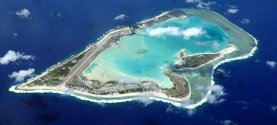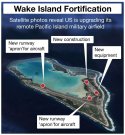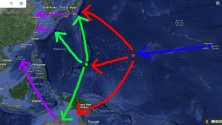Slightly deviating from the discussion here, but there is something that I would like to talk about one of the IRBMs of the PLARF, i.e.
DF-26.
The DF-26 IRBM has been widely known as the "Guam Express" or "Guam Killer" - Mainly because Guam and US warships sailing around the same distances from China are meant to be covered within the firing range of the DF-26.
The publically available values on the
range of the DF-26 is around
4500-5000 kilometers. However, the
distance between Guam and Shanghai is only around
3000 kilometers.
Of course, you would have around
1500-2000 kilometers of
buffer zone that the PLARF could use, for instance, to station DF-26 TEL launchers deep inside China's interior and better shield them against American and Japanese strikes coming from the seas to the east - Which is a very good thing. However, allocating so much buffer distances for the DF-26 just doesn't seem right if the IRBM is indeed only meant for targets as far out as Guam.
Therefore, I took some look around the Westpac, and this one -
Wake Island - caught my attention. As seen with the bird-eye-view of the island, there is
a sizeable USAF military base on Wake.
View attachment 104648
Wake Island is located around
3/5th the way from Hawaii to Guam, and is around
4700 kilometers away from Shanghai. That would mean if we
take the maximum range of DF-26 and project it all the way to Wake, that would leave around
300 kilometers of buffer zone from the Chinese coast.
Of course, I would like to stress that the 5000 kilometers-range may very well be achievable only if the DF-26 has a lighter payload, and that having heavier payload would restrict the DF-26's range to just Guam. There is also the point where 4700 kilometers is basically nearing the edge of the 5000-kilometer-range effective coverage of the DF-26.
However, even if the above assumptions are indeed true, I couldn't find the justification that even if the DF-26 is really meant for targets as far out as Guam - Would require such long range of coverage.
There is also the actions taken by the US military to expand operations and reinforce the defences on Wake:
View attachment 104650
We know that the US military has been working to disperse and strengthen their assets across the WestPac in face of the ever-growing threats by the PLARF and PLAAF against key US military installations along the First and Second Island Chains.
Have a look at this map illustration.
View attachment 104652
Blue dot refer to
Hawaii;
Red dot refer to
Wake;
Green dot refer to
Guam; and
Purple dots refer to
Yokosuka+Yokota,
Kadena and
Tindal, respectively.
You can note that
Guam is essentially a
key node for US military forces to move about in the Westpac. Meanwhile,
Wake is a
stepping stone between Guam and Hawaii. Also noted is the stage-by-stage east-to-west deployment of US power projection across the Pacific.
In this context, Wake could become very useful as
a standby frontline military command and operation basing location. To put it simply, in case everything within the First and Second Island Chain are rendered inoperable by PLA strikes, the command and operation basing centers on Guam
can be evacuated to the secondary location on Wake. In essence, Wake can be considered as an
extension of the Second Island Chain.
Therefore, if the
US military base on Wake could also be knocked out of commission with the
DF-26, the remaining choice left for the US military would be to have their command and operation basing center
retreated back to Hawaii.
This makes me think that the designers and engineers for the DF-26 could very well have
took the capability of striking Wake Island into serious account when setting parameters for the missile. Perhaps the DF-26 shouldn't be called "Guam Killer", but instead "
Guam Killer-but-don't-ever-think-that-Wake-is-safe-from-PLARF".
But even if the DF-26 currently in service with the PLARF does not have sufficient range to reach Wake, or the cost-to-payload ratio of the DF-26 may not be feasible enough to justify such strike missions - Perhaps future/WIP variants of the DF-26 (e.g. DF-26A/B) with longer ranges and larger payload capacity certainly could allow Wake to be targeted more easily.
I know that there are other DF missiles which are definitely more comfortable with covering Wake i.e. DF-31, DF-41 and the upcoming DF-27. However, this post is just touching more on the DF-26's potential capabilities in long-range WestPac strike missions on my own initative.



